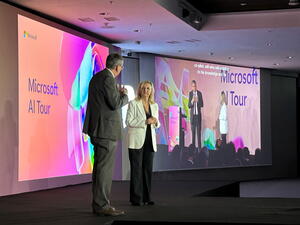Microsoft and ITER to harness the power of AI
While ITER has been using Microsoft tools for years, the two organizations have now begun a formal collaboration that may yield benefits never thought possible.
Cooperation ramped up a notch last week when the two organizations signed a Memorandum of Understanding to work together to apply artificial intelligence (AI) and other digital technologies to help engineers construct the ITER machine and accelerate research in nuclear physics.
Inspired by what he learned from case studies, ITER’s Deputy Director-General and Chief Scientist Alain Bécoulet began developing a closer relationship with Microsoft in 2023. He had already been pushing to increase the use of digital technology, including facilitating document retrieval from ITER’s document management system with Microsoft Copilot (a new tool was recently released). According to Bécoulet, helping researchers manage the knowledge gained throughout the project is as precious as the end product. “We want to stabilize this knowledge into codes and standards, so that next time somebody addresses the construction of a nuclear reactor or reactor-like machine, they just build up on what has been done and not reinvent the wheel,” he says.
Both organizations recognized the value in increased collaboration: scientists and engineers are deeply skilled in their own field but much less so in AI, while companies like Microsoft who are at the forefront of AI can, through collaboration, help scientists like those working in nuclear fusion to harness its power. The gains reaped from working together could exceed the sum of what each could produce alone.
A collaboration with a range of expected benefits
ITER is particularly interested in working with Microsoft Research, which was created in 1991 and now employs hundreds of people performing fundamental research in a range of areas, including social sciences.
When generative AI came on the scene three years ago, Microsoft Research created a whole new department, called AI for Science. “We understood that with new generative AI models, AI would be transformative,” says Philippe Limantour, Chief Technology and CyberSecurity Officer at Microsoft France. “So we decided to build teams with AI specialists, data scientists, and researchers in different fields to work together, applying AI to solve the most complex problems like developing new drugs, or discovering new materials.”
For ITER, the payoff could come in the form of facilitating precision construction or strengthening plasma modelling. For example, AI can serve as the underpinning for digital twins that will help assembly crews choose the best fix virtually, or it can help review the reams of data produced during vacuum vessel assembly and welding and save time in verifying the quality and precision of the work.
Digital twins will also help physicists make predictions about plasma behaviour in different scenarios. They can also be used to generate synthetic data to train AI models—and test scenarios to help run experiments. “The aim is to strengthen the integrated modelling of ITER plasmas, both in terms of experimental design and real-time control, as well as the analysis and processing of gigantic quantities of data,” Bécoulet explains, adding that the cooperation could also lead to a major leap forward in ITER’s ability to optimize its operational regime based on the most fundamental calculations through simulations that call on the highest computing capacities currently available as well as solid data mining capabilities.
While AI is one of the main areas of collaboration, it is not the only one. Microsoft offers high-performance computing as a service, and its engineers are experts in adapting software to the rapidly evolving architectures of the world’s fastest machines. Many of the codes used for physics simulations at ITER were written in the 1970s and do not take advantage of the massively parallel processing and GPU operations available today. Microsoft experts can help adapt that software to make it run much faster on modern hardware—and keep doing so as the machines get better.
Given the evolutive nature of digital technology, and the enthusiasm on both sides, Bécoulet expects big benefits over the years.


